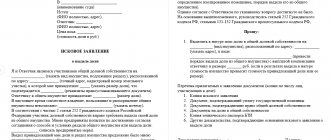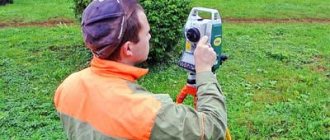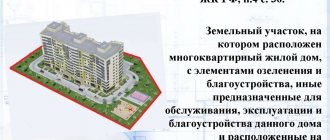In some cases, persons who have ownership rights to a share in a land plot have a desire to dispose of their property independently, so they initiate the removal of the boundaries of the land plot (ОPrav _ 167). To obtain the desired result, you will need to go through a procedure established in legislative acts.
To carry out the procedure under consideration, it is necessary to understand what the nature of the types of property relative to a joint land plot consists of. Joint property is divided into:
- general, in which shares are not subject to allocation;
- collective - a situation where each of the rights holders is allocated a specific share in the plot.
[contents]
The first type gives each owner the right to use the entire territory of the allotment, as well as other users. An agreement is reached between the owners, confirmed verbally.
Persons who have property rights have the opportunity to establish boundaries of conditional purpose, but they are not endowed with legal force. Joint cultivation of the land is also allowed, in which case the results obtained from the plot are subject to equal division. In this case, we can say that any partition options that are agreed upon may apply.
Allocation of a plot against a land share
If there is a division of the plot into shares, then the rights of each owner are subject to specific establishment. The documentation that has legal significance reflects the size of the person’s share.
Such an allotment can be divided by carrying out land surveying and allocating everyone’s share; the boundaries of the land plot are also established (ОPrav _ 169-170). They can allocate only one share if such a need arises.
Allocation of share in 2021
When it comes to shared ownership, we can say that it can be divided between the owners in equal parts, and uneven distribution is also allowed. The size of the land plot is determined in accordance with the share of a person's right to land.
In a situation where share owners want to carry out the procedure for separating their parts, they will need to jointly contact an organization engaged in geodetic activities.
Determining the memory size
The cadastral engineer checks the documentation of a legal nature, after which the possibility of carrying out boundary actions is considered. The engineer draws attention to the corresponding map.
If the plot is not large, then initially you need to contact the municipal administration. This is done in order to find out the minimum that is established in the region regarding the size of the plots.
Each share that receives independent status should not be smaller than the size established by the legislator. When persons ignore this provision and the site has a smaller area, registration will be refused.
It is worth noting that carrying out surveying activities will not help to obtain the desired result. Cadastral authority employees have no obligation to conduct consultations regarding the issues under consideration. Land surveying is carried out at the initiative of the owners, which is expressed in the application drawn up; the municipality’s regulations are not taken into account.
If one person has the right to a larger part of the plot than the second, and the first initiates the division, the procedure proceeds in a similar way. In the case where both parts of the plot are less than the minimum applicable in the region, both of them cannot be put on cadastral registration.
Therefore, this issue should be considered by the copyright holder before contacting a geodetic company. When only one share owner plans to allocate a part, he will need to obtain consent to this from the remaining rights holders.
How is a section different from a section?
Expert opinion
Stanislav Evseev
Lawyer. Experience 12 years. Specialization: civil, family, inheritance law.
Partition is a procedure in which two or more new ones are formed from a common land plot. In this case, the divided plot actually ceases to legally exist. After the division of the land, all co-owners remain in their right to dispose (jointly or by prior agreement) of all the formed plots. This is enshrined in law in paragraph 3 of Art. 11.4 Land Code of the Russian Federation.
But after the procedure for allocating a plot, each former co-owner of the joint land will have the right to dispose only of the plot that was formed in proportion to his share in the common ownership.
Another difference is that an allotment can only be made from shared ownership, while division can be carried out in relation to plots that are both jointly and sharedly owned. Moreover, after the allocation, the common area remains, but within new boundaries. And after the division, the original object is legally liquidated.
However, there are two exceptions to this rule:
- division of territories belonging to gardening non-profit partnerships;
- division of land owned by the state or municipality.
These territories, after carrying out the appropriate procedure, in accordance with the norm of paragraph 1 of Art. 11.5 of the Land Code of the Russian Federation, remain within the same boundaries.
A single owner can also divide a land plot. For example, if he needs to subsequently sell part of an overly large plot. But the allotment implies the participation of at least two co-owners.
Cost and process of division in 2021
The price for the services in question is quite high. The following factors influence it:
- the price of land plots in the total mass;
- the status of the company carrying out geodetic work;
- the amount of cost for the work in question for the subject;
- the area of the land;
- status that a locality has.
As an example, agricultural lands are valued lower than those intended for individual housing construction. Also, work carried out in the near and far Moscow region differs in cost by up to 10 times.
Sample application for division of land
In addition to the fact that the applicant is required to pay for geodetic and cartographic work, some localities establish as an additional payment the cost of transportation for surveyors regarding arrival at the site. You are allowed to bring them to the place yourself.
The division process begins after the necessary documentation has been prepared and geodetic work has been paid for. Before land surveying begins in real life, specialists develop a diagram that serves as the basis for the work being carried out. After preparing a preliminary project, surveyors visit the plot and carry out demarcations according to what the customer indicated.
When the procedure is carried out between two or more owners, several nuances must initially be taken into account:
- all plots have separate access to the road;
- sections are formed in such a way as to have an even shape relative to the geometry, that is, there should be no wedges or anything else;
- There should be no overlap of allotments, as well as crossing and displacement of boundaries (OPrav _ 171,).
When the listed requirements are not met, land surveying cannot be carried out. The result of land surveying is that engineers carry out a geodetic survey, verify whether the plot corresponds to the established dimensions, and then begin dividing it into shares.
Company employees set boundaries that will divide independent plots. Within the boundaries, the right of a particular person applies. The owner can use it at his own discretion.
Stages of land surveying
During the work, employees of geodetic companies install boundary signs; they are contained in marks that are established by standards. At the initial stage, they appear in the form of temporary pegs; after the marking is completed, a permanent location is determined for them. Major formatting of the main points is also being carried out.
Those signs that are installed are prohibited from being changed arbitrarily until a new survey is carried out. Marks are entered on the allotment map and indicated in accounting records.
The boundaries established during boundary work have legal force and are confirmed in the relevant records. After part of the share has been allocated and boundaries have been drawn, the owner remains to go through the procedure of registering rights to the allotment. To do this, you need to contact the cadastre and cartography department.
In this case, you will need to provide documentary evidence of land surveying:
- boundary project;
- an act confirming the achievement of agreement with neighbors;
- permission to perform this procedure by the remaining owners;
- the act according to which boundary signs were installed.
Act of approval of the location of the land plot limits
With the listed papers, you need to visit the cadastre department and register the plot of land. After receiving the cadastral passport, you will have to collect a new package of documents:
- acts that have legal significance for the allotment;
- cadastral documents;
- evidence of the establishment of boundary signs.
Such documents will be required to register the owner's rights. It is worth considering that after the allotment procedure is implemented, the applicant will only have the deed of title to the old allotment in his hands. Regarding a new site, such a document will be a land surveying act.
Attention! The file cannot be used as a document. It is for informational purposes only.
The Civil Code of the Russian Federation provides for two types of common property (owned by several persons) - shared and joint. Shared ownership involves dividing property between owners into shares. Common ownership of property is shared, except for cases where the law provides for the formation of joint ownership of this property (clause 3 of Article 244 of the Civil Code of the Russian Federation).
The rules of the Civil Code of the Russian Federation on shared ownership also apply to shared ownership of land plots. Special rules are provided for by land legislation. It is necessary to take into account that when considering issues of shared ownership, the so-called ideal shares are taken into account - the right is divided, not the land plot. If the owners need to determine who owns specific parts of the land plot, they should make a division or allocation of the plot (Articles 11.4, 11.5 of the Land Code of the Russian Federation, Article 252 of the Civil Code of the Russian Federation). If the allocation of a share is impossible, the owners can determine the procedure for using the property (Article 247 of the Civil Code of the Russian Federation). Common ownership of a land plot arises in the following cases: - two or more persons acquire property that cannot be divided without changing its purpose (indivisible things) or is not subject to division by force of law. For example, when inheriting an indivisible land plot by several heirs; acquisition of ownership of one plot of land by several persons who are not spouses or participants in a peasant (farm) enterprise; upon sale (donation) by the sole owner of a share in a land plot belonging to him; - by agreement of the parties, shares in common joint property are determined (for example, when spouses enter into a marriage contract) - clause 5 of Art. 244 Civil Code of the Russian Federation; - division of property in common joint ownership occurs by court decision (for example, when dividing jointly acquired property of spouses, allocating a share in the right of common property) - clause 5 of Art. 244 Civil Code of the Russian Federation. The determination of shares in the right of common shared ownership of a land plot is carried out in accordance with the general procedure established by Art. 245 of the Civil Code of the Russian Federation. If the shares of participants in shared ownership cannot be determined on the basis of law and are not established by agreement of all its participants, the shares are considered equal (clause 1 of Article 245 of the Civil Code of the Russian Federation). The law provides for cases when the size of the owners' shares can be changed. In the process of owning and using a land plot, it (like any other property) can be transformed and improved through the contributions of co-owners. Clause 2 of Art. 245 of the Civil Code of the Russian Federation provides that by agreement of all participants in shared ownership, a procedure for determining and changing their shares can be established depending on the contribution of each of them to the formation and growth of common property. It is also necessary to take into account that a participant in shared ownership, who has carried out inseparable improvements to this property at his own expense in compliance with the established procedure for the use of common property, has the right to a corresponding increase in his share in the right to common property (clause 3 of Article 245 of the Civil Code of the Russian Federation). In relation to separable improvements, the rule applies that they become the property of the participant who made these improvements. Possession, use and disposal of land plots in shared ownership are regulated by the general provisions of the Civil Code of the Russian Federation on shared ownership (Articles 246, 247 of the Civil Code of the Russian Federation). Possession and use of property is carried out by agreement of all participants in shared ownership, and if agreement is not reached, in the manner established by the court. Each participant in shared ownership has the right to own and use part of the common property on an equal basis with the other participants in shared ownership. The part of the property provided for use must be proportional to the share owned by the owner. If this is not possible, he has the right to demand compensation. If there is real estate on the land plot, it is necessary to take into account the rights of the owner of the said property (regardless of whether he is the owner of one of the shares of the land plot). The owner of real estate located on someone else's land plot has the right (clauses 1, 3 of Article 271 of the Civil Code of the Russian Federation): - to use the land plot; - own, use and dispose of real estate belonging to him at his own discretion (including demolishing relevant buildings and structures). The disposal of property in shared ownership is also carried out by agreement of the owners. The law grants the right to a participant in common property to dispose of his share at his own discretion (sell, donate, bequeath, pledge, etc.). If alienation for compensation is expected, it is necessary to comply with the rules of Art. 250 of the Civil Code of the Russian Federation on the pre-emptive right to purchase. Land legislation also contains special rules related to the disposal of land plots. Thus, an additional basis is provided for applying the rule of pre-emption in the event that there are buildings on the land plot. The owner of a building or structure has a pre-emptive right to purchase or lease a land plot by analogy with the procedure established by civil law for cases of sale of a share in the right of common ownership to an outsider (Clause 3 of Article 35 of the Land Code of the Russian Federation). When disposing of a land plot, peculiarities may arise related to the subject composition of the owners. For example, foreign citizens, stateless persons and foreign legal entities cannot have ownership of land plots located in border territories and other special territories (Clause 3 of Article 15 of the Land Code of the Russian Federation). Therefore, it is impossible to sell (or otherwise transfer) a share of such land to them. Agricultural lands have a special status (they do not include garden and vegetable plots located on agricultural lands, land plots intended for personal farming, garage construction (including individual garage construction), as well as land plots on which real estate objects are located) – clause 1 of Art. 1 of Federal Law No. 101-FZ of July 24, 2002 “On the turnover of agricultural land”, hereinafter referred to as Law No. 101-FZ). Possession, use and disposal of a land plot of agricultural land, which is in shared ownership of more than five persons, is carried out in accordance with the decision of the participants in shared ownership, which is adopted at the general meeting of participants in shared ownership (Article 14 of Law No. 101-FZ). Certain restrictions are imposed on a participant in shared ownership of a land plot from the category of agricultural land. He may, at his own discretion, without allocating a share: - bequeath a share; - renounce ownership of the land share; — contribute it to the authorized (share) capital of the agricultural organization that uses this land plot; — transfer your land share into trust management or sell or donate it to another participant in shared ownership; - transfer your land share into trust management, or sell or donate it to an agricultural organization or citizen - a member of a peasant (farm) enterprise that uses this land plot. If the owner wants to dispose of the share in a different way (for example, sell it to a third party), he must first allocate the share belonging to him (Article 12 of Law No. 101-FZ).
Allocation of shares through the court
Situations may arise when the issue regarding allocation is resolved in court. Such situations include:
- there are no documents of legal significance;
- the size of shares is not determined in the documentation;
- when the right to a plot is obtained as a result of inheritance legal relations;
- persons living in the neighborhood or other owners did not express their consent;
- there is no agreement on the size of the allotment in common law;
- obstacles set by the municipality;
- controversial situations with neighbors regarding established boundaries.
Statement of claim to determine the share in joint property
In addition to the listed problems, other problems can be resolved through a court hearing. The basis for going to court is a violation of human rights enshrined in the Constitution. These rights are connected with the right to land allotment.
The decision made by the court has the force of a legal act. This means that with the help of this document it is possible to solve all existing problems regarding rights to land.
You will need to contact the district court located at the location of the plot regarding which the dispute is ongoing. You will need to collect a certain package of papers that will act as evidence. When difficulties arise with the evidence base, witness testimony can be used.
When drawing up a claim, you must pay attention to the reason for filing the application. It is reflected clearly and correctly from a legal point of view. When it comes to benefits that a person could have received, but did not receive due to obstacles that arose, the exact amount must be calculated and stated in the claim. It also indicates how the calculation was carried out.
It should be remembered that when filing claims of a property nature, you are required to pay an additional state fee, which does not guarantee that the decision will be made in favor of the plaintiff. In this connection, you need to think in advance what evidence is available.
The documents that will be attached to the claim are reflected in it as a separate list. The period allotted for consideration of the stated claim, according to the law, is no more than two months. If the court finds the evidence unconvincing, the hearing will be postponed and the deadline will be delayed.
Attention! The file cannot be used as a document. It is for informational purposes only.
How to allocate a land plot in kind from common shared ownership
If one (or several) co-owners need to allocate part of the property for sole ownership, then there are two ways to proceed:
- Enter into an agreement with the other owners. This is the most preferred option.
- Apply to the district court with a claim for the allocation of a plot of land from common property.
This may be necessary under the following circumstances:
- there are no documents confirming the right to own and dispose of shares;
- documents are available, but an error was made in the size of the share or other information (about the plot, owner, etc.);
- the impossibility of reaching an agreement and concluding a pre-trial agreement with the remaining co-owners;
- the presence of controversial issues with the local administration regarding the ownership of the site;
- other reasons requiring a mandatory court decision (inheritance disputes, division of property between family members, etc.)
By agreement
Despite the fact that concluding an agreement is considered a simplified procedure for allocating a share from joint property, it is worth following a certain procedure and knowing all its nuances. Let's take a closer look at them.
Procedure
In order to avoid contacting the judicial authorities, you will have to follow a certain algorithm.
Namely:
- Meeting of co-owners. Anyone who wants to allocate part of the land for individual ownership gathers all the owners of the land. They jointly draw up minutes of the meeting, in which they indicate that each of them agrees to the allocation of a share(s), the size, location, and other conditions of the new plot(s) are determined.
- Carrying out land surveying. Typically, the specialist’s services are paid for by those who wish to separate their part of the land. However, in some cases, all owners can agree to share the cost of the work.
- Coordination of survey results. All co-owners, as well as the owners of neighboring plots, gather again. The conclusion of the cadastral specialist is communicated to everyone. All objections are entered or the consent of the parties to the transaction is noted.
- Approval by the cadastral chamber. After agreement with the co-owners and neighbors, the boundary plan is sent to the regional cadastral chamber, where the new site is given an address and assigned a number.
- Registration of rights. A corresponding application and a package of documents are submitted to the Rosreestr branch, on the basis of which changes are made to the Unified State Register.
Required documents
In order to register the plot allocated under the agreement as individual property, you must go to the Rosreestr branch.
The following documents must be attached to the application:
- application (drawn up according to the sample that will be provided by the Registration Chamber);
- passport of the new owner;
- minutes of the meeting of the co-owners of the divided plot;
- cadastral passport;
- conclusion on land surveying (plan);
- extract from the Unified State Register of Real Estate on the ownership of the land plot;
- if the procedure is carried out through a representative, then a certified power of attorney and his passport.
Deadlines
The total duration of the procedure consists of the duration of all stages:
- reaching an agreement - depending on the number of owners and their attitude towards the allocation, usually this process does not take more than 2 weeks;
- boundary work and preparation of technical documentation - depends on the selected cadastral engineer, as well as on the workload of the BTI. Usually this stage is the longest and takes at least 1 month;
- registration of rights – 14 days from the date of filing the application and providing all documents.
Thus, you are unlikely to be able to allocate a plot in less than 2 months.
Price
The only fixed fee that you will have to pay is 2,000 rubles for registering ownership of a new land plot.
All other expenses depend on the region. For example, boundary work costs from 5,000 to 30,000 rubles.
Sample agreement
There is no exact form of this document, but the general content is most often the same.
Grounds for land surveying and specifics of the process
The basis for carrying out boundary actions is the desire of the person who has property rights regarding the share in the site. It is worth keeping in mind that such a right must be confirmed with the help of documentation.
When shares in common property are not determined, the procedure will be different. If the plot is in common ownership, the shares of which are not allocated, the owner will need to carry out the allotment procedure. This share may be allocated on a voluntary basis.
Allocation of land plots without holding a general meeting of owners of land shares
In such a situation, all co-owners must draw up an application and submit it to the local administration. Next, an agreement of the parties is provided, which indicates what share belongs to each owner. After such actions, municipal authorities issue permission to carry out the allocation procedure. This act is subsequently submitted to the company conducting geodetic activities.
If a peaceful resolution of the issue is not achieved, the co-owners can resolve it by going to court. Most often, the issue under consideration is resolved regarding plots owned by partnerships. It is established that each summer resident has the authority to initiate this procedure.
The issue regarding land surveying is decided at a meeting where all summer residents participate. An application for the allocation of shares is submitted to the chairman. The deadline for submission is set no later than one month before the start of geodetic work. When such deadlines are missed, the procedure may be declared illegal in court.
The same conditions are observed by persons who have a share in the rights according to other legal precedents. When one owner has decided to allocate, he can do this if:
- when, after the procedure, all areas comply with established standards;
- if the owners do not speak out against the allocation;
- notification of the survey work was sent to the remaining owners no later than a month before its start.
If controversial issues arise, they are easily resolved through a court hearing. The court will take the position of the party that has complied with all legal provisions and presented the necessary evidence.
Conditions
In order to allocate a land plot from common shared ownership, certain conditions must be met:
- Determining the possibility of causing significant economic damage. If this is possible, then the procedure will not be legal. Regardless of the size of the allocated part of the plot, the remaining co-owners can prohibit the allocation in court.
- Insignificance of the share. If the share in the common property is so small that it cannot be allocated in kind, then this situation is regulated by the norm of paragraph 4 of Art. 252 of the Civil Code of the Russian Federation. In accordance with it, the owner (owners) of the remaining shares must buy out the allocated part from the co-owner. The cost is determined either by a settlement agreement or by a court decision.
In addition to the size, there are several more mandatory requirements for allocating an allotment in kind, namely:
- each of the newly formed areas must be provided with unhindered access (travel, passage);
- the boundaries of all new plots may have territorial intersections (common areas).
It is also worth considering that the actual size of the allocated share may differ from the ideal share proportion. This is due to the fact that during the surveying of a new site, a cadastral engineer, due to the characteristics of the soil or topography, may enter data into the conclusion, according to which the size of the allocated plot will change. This is legally enshrined in paragraph 5 of Art. 13 Federal Law No. 101.
Features for allocating land for agricultural purposes
The procedure under consideration has its own characteristics in relation to lands allocated for agriculture. This is due to the fact that plots belonging to this category are located in one massif, among which there are fields, meadows, and pastures.
The procedure for privatizing a small plot can cause difficulties for an entity that carries out economic activities. In this regard, the allocation process is implemented by local authorities quite reluctantly. The municipality preferably concludes lease agreements.
Registration of a plot of agricultural land
In most cases, the municipality makes a decision on allocation, after purging and weighing all the nuances. It will be easier to obtain the right to allotment if you initially draw up a lease agreement for the site. This means that individual entrepreneurs at a certain point may initiate a procedure for allotment of such lands. After this, the land is registered as the property of the individual entrepreneur.
In such a situation, the allocation is made according to the discussed algorithm, which is established for cooperatives of summer residents, but you will need to obtain permission from the municipal administration. A ban has been established regarding the allocation of plots from lands related to:
- to areas under special protection;
- protected areas;
- forest and water resources;
- fertile soils.
The remaining plots are allocated at the discretion of the administration.
What documents confirm the right to part of the joint property?
The right to dispose of property must be documented. New property must be registered in the unified real estate register, and the owner, at the end of the procedure, is issued an extract from the Unified State Register of Real Estate (Clause 1, Article 28 No. 218-FZ).
It is she who confirms the right to own real estate from 2021. This is the so-called legal document. For a plot acquired before 1998, the document confirming ownership is a Certificate issued by the “land committee” of the municipality or an extract from the household register; from 1998 to July 15, 2021 – certificate of state registration of rights; after this date - an extract from the Unified State Register.
There are also title documents. They explain on what basis this or that object was transferred to the owner. Legal acts for land plots include (Article 8 of the Civil Code of the Russian Federation):
- agreements on the alienation of property and acceptance acts thereto;
- any court decisions;
- certificates of inheritance;
- documentary transactions (donation, barter, purchase and sale, rent).
As for common ownership of land plots, the situation depends on the type of ownership: shared or joint.
Joint ownership can arise in a number of limited cases:
- during the formation of peasant farms (Article 257 of the Civil Code of the Russian Federation);
- among SNT participants;
- for spouses who have not concluded a marriage contract (Article 256 of the Civil Code of the Russian Federation).
The reasons for obtaining such plots can also be completely different, primarily:
- any documentary transactions concluded during marriage;
- certificates of inheritance, etc.
For common shared ownership, the title documents may be:
- transactions (donation, barter, purchase and sale, rent);
- transfer of ownership of a share in property rights by inheritance (inheritance by law or by will);
- privatization of housing, i.e. free transfer to citizens of residential premises owned by the state;
- recognition of ownership of a certain share by a court decision.
Note! Title and title documents are inextricably linked. It is possible to register property only on the basis of acts confirming the emergence of property rights.
If for some reason the data on registration of ownership is not in the state register, it will be possible to obtain a document for the plot only on the basis of title documents.
When does common shared ownership of land arise?
Common property can arise in a variety of cases, we will give the most common:
- In case of purchasing a plot of land using common money. For example, members of a farmers' association collected common funds and bought a plot of land.
- Everyone received a share in proportion to the funds contributed.
- When purchasing land during marriage, the property automatically becomes common to both spouses, unless otherwise provided by the marriage contract.
- Due to the trace of purchase and sale for several persons.
- In case the property is indivisible.
- If the plots of land fall under farming or peasant education.
- When the contract provides for the construction of a house for several persons.
- In case of connection or displacement of property. For example, two private plots are combined into one as common property.
The provision of land plots to disabled people occurs on preferential terms in accordance with the legislation of the Russian Federation. Do you need a sample contract for the sale and purchase of a share of land? You can download it here.
If you want to donate a house with a plot of land, you must be prepared to collect a package of documents. You will find out what papers you need to prepare by reading our article.










